
Air Force Common Admission Test
(AFCAT) -1/2012
Directions (Qs. 1-5): Read the following passage carefully and answer the questions given below:
Pablo Picasso showed his truly exceptional talent from a very young age. His first word was lapis (Spanish for pencil) and he learnt to draw before he could talk. He was the only son in the family and very good-looking, so he was thoroughly spoilt. He hated school and often refused to go unless his doting parents allowed him to take one of his father’s pet pigeons with him.
Apart from pigeons, his great love was art and when in 1891 his father, who was an amateur artist, got a job as a drawing teacher at a college, Pablo went with him to the college. He often watched his father paint and sometimes was allowed to help. One evening his father was painting a picture of their pigeons when he had to leave the room. He returned to find that Pablo had completed and picture, and it was so amazingly beautiful and lifelike that he gave his son his own palette and brushes and never painted again. Pablo was just thirteen.
1. As a boy Pablo Picasso was
(A) Ordinary looking but talented.
(B) Handsome and talented.
(C) Handsome and studious.
(D) Handsome and hardworking.
2. He was spoilt mostly because he was
(A) A smart boy.
(B) Loved by one and all.
(C) The only son in the family.
(D) Always surrounded by notorious boys.
3. Picasso went to school only when
(A) His friends accompanied him.
(B) His father went with him.
(C) He was allowed to paint at school.
(D) He was allowed to carry a pet with him.
4. When his father painted in the college, Pablo
(A) Occasionally helped him.
(B) Rarely helped him.
(C) Always helped him.
(D) Invariably helped him.
5. Pablo’s father gave up painting because he
(A) Did not like the job.
(B) Retired from the college.
(C) Was impressed by his son’s talent.
(D) Lost interest in painting.
Directions (Qs. 6-10): In each of the following questions, find out which part has an error.
6. The boss was irritated (A)/by him neglecting (B)/the duties and (C)/ not listening to his advice (D).
7. Each of the three (A)/beggars were (B)/asking for more (C)/ food to eat (D).
8. My brother sent (A)/two pairs (B)/of shoe (C)/from America (D).
9. The young boy said (A)/that he (B)/neither liked me (C)/nor my wife (D).
10. He was (A)/congratulated for (B)/ his success in (C)/ the 100 m race (D).
Directions (Qs. 11-15): Pick up the most effective word from the given words to fill in the blanks to make the sentence meaningfully complete.
11. Sanjay was _____ with divine vision to see the great battle.
(A) Demure
(B) Authorized
(C) Endowed
(D) Uttered
12. There was so much _____ material in the essay that it was difficult to get the author’s message.
(A) Variegated
(B) Superficial
(C) Extraneous
(D) Exemplary
13. The world is so constructed that if you wish to enjoy its pleasures, you must also _____ its pains.
(A) Deny
(B) Neglect
(C) Ignore
(D) Endure
14. Indian press did not give _____ to the British publicity.
(A) Credence
(B) Scion
(C) Augury
(D) Opportunity
15. Travellers _______ their reservations well in advance if they want to travel during the Diwali holidays.
(A) has better to get
(B) has better get
(C) has to get better
(D) had better got
Directions (Qs. 16-18): In each of the following choose the word most similar in meaning to the word given in capitals.
16. EMANCIPATE
(A) Set free
(B) Exist
(C) Correct morally
(D) Restrain
17. DECEIT
(A) Simplicity
(B) Gentility
(C) Sincerity
(D) Dishonesty
18. ADMONITION
(A) Thrash
(B) Hindrance
(C) Warning
(D) Exhort
Directions (Qs. 19-20): In each of the following, choose the word most nearly opposite in meaning to the word given in capitals.
19. VOCIFEROUS
(A) Laudable
(B) Quiet
(C) Dangerous
(D) Powerful
20. IMPLICATE
(A) Involve
(B) Exonerate
(C) Corrupt
(D) Accuse
Directions (Qs. 21-40): Choose the correct answer.
21. The person who is regarded as the greatest law giver of ancient India is
(A) Panini
(B) Kautilya
(C) Manu
(D) Patanjali
22. The immortal fame of Ashoka largely rests upon
(A) His conversion to Buddhism and its propagation.
(B) His policy for the welfare of his subjects.
(C) His work in the sphere of politics and moral teaching.
(D) His extensive conquests.
23. Gandhiji started Dandi March
(A) The demonstrate against the British Empire.
(B) To break the salt law.
(C) To boycott foreign goods.
(D) None of the above
24. The first war of Indian Independence began on 10 May 1857 at
(A) Meerut
(B) Jhansi
(C) Barrackpore
(D) Delhi
25. The sun rises in Arunachal Pradesh two hours before it does in Dwaraka in Gujarat. This is because the former is
(A) Higher in elevation than Dwaraka and the earth rotates from West to East.
(B) Situated further North than Dwaraka and the earth rotates from West to East.
(C) Situated further East (about 30° Longitude) than Dwaraka and the earth rotates from West to East.
(D) Situated about 30° East of Dwaraka and the earth rotates from West to East.
26. Srinagar is situated on the banks of the river
(A) Ravi
(B) Sutlej
(C) Jhelum
(D) Chenab
27. The areas in India that receive approximately an average of more than 200 cms of rainfall annually are
(A) Meghalaya, Assam, Nagaland, Arunachal Pradesh.
(B) Odisha, Madhya Pradesh, Gujarat, Maharashtra
(C) Meghalaya, Assam, Rajasthan, Jammu & Kashmir
(D) Meghalaya, Delhi, Punjab, Rajasthan
28. Isotherms are imaginary lines drawn on a map which connect places of equal
(A) Atmospheric pressure
(B) Humidity
(C) Rainfall
(D) Temperature
29. Jim Corbett National Park is situated in which state?
(A) Arunachal Pradesh
(B) Himachal Pradesh
(C) Andhra Pradesh
(D) Uttarakhand
30. Which one of the following statement regarding the sun is correct?
(A) The sun is composed mainly of hydrogen.
(B) Its energy is generated by nuclear collision in its interior.
(C) It is calculated that the sun consumes about a trillion pounds of hydrogen every second.
(D) All of the above
31. Supersonic speed is speed greater than the speed of sound (in air at sea level) that is to say around ______ miles/hour.
(A) 760
(B) 860
(C) 960
(D) 1060
32. Yoga Sutra was written by
(A) Vatsyayana
(B) Patanjali
(C) Bhratrihari
(D) Maharshi Mahesh
33. The National Institute of Oceanography is located at
(A) Trivandrum
(B) Panaji
(C) Cochin
(D) Mangalore
34. An aeroplance rises because
(A) Of upward reaction of air.
(B) The density of air above the plane is less than below it.
(C) The pressure above its wings is less than the pressure below them.
(D) Its nose points upwards.
35. Rocks formed on the solidification of molten matter are called
(A) Metamorphic rocks
(B) Sedimentary rocks
(C) Volcanic rocks
(D) Igneous rocks
36. The pioneer of Atomic energy in India is
(A) Homi J. Bhabha
(B) Vikram Sarabhai
(C) C. V. Raman
(D) C. K. Naidu
37. Which one of the following statements regarding FIFA World Cup 2010 is not correct?
(A) South Africa became the first host nation to fail to qualify for the tournament’s second round.
(B) The tournament was the culmination of a qualification process that began in August 2007.
(C) This is the first time that the tournament was hosted by an African nation.
(D) Zakumi, the official mascot for the FIFA World Cup, 2010 is an African bush elephant.
38. The first Indian to win the World Amateur Snooker Championship is
(A) Om Agarwal
(B) Geet Sethi
(C) Michael Ferreira
(D) Wilson Jones
39. The first person to win the Arjuna award for badminton is
(A) Pullela Gopichand
(B) Prakash Padukone
(C) Nandu Natekar
(D) Farook Engineer
40. The sport which requires the largest field is
(A) Football
(B) Cricket
(C) Hockey
(D) Polo
Directions (Qs. 41-45): Find the odd one out.
41.
(A) Advice
(B) Counsel
(C) Direct
(D) Suggest
42.
(A) Tumble
(B) Topple
(C) Crumble
(D) Sprain
43.
(A) Sobriquet
(B) Alias
(C) Pseudonym
(D) Anonymous
44.
(A) Mumbai
(B) Goa
(C) Visakhapatnam
(D) Thiruvananthapuram
45.
(A) Petrol
(B) Acetone
(C) Mercury
(D) Kerosene
Directions (Qs. 46-55): In the following questions, the words given bear a certain relationship. Your task is to find out from the choices the words with the same relationship.
46. Hope : Despair
(A) Work : Failure
(B) Worship : Adore
(C) Cow : Milk
(D) Encourage : Dishearten
47. Army : Logistics
(A) War : Logic
(B) Soldiers : Students
(C) Business : Strategy
(D) Team : Individual
48. Bouquet : Flower
(A) Skin : Body
(B) Chain : Link
(C) Product : Factory
(D) Page : Book
49. Revenge : Vendetta
(A) Sleep : Dream
(B) Sun: Moon
(C) Envy : Jealousy
(D) Heaven : God
50. Refine : Style
(A) Retouch : Photograph
(B) Paint : Wall
(C) Compose : Song
(D) Author : Book
51. Fear : Tremble
(A) Hand : Shake
(B) Heat : Perspire
(C) Distance : Walk
(D) Evening : Star
52. Condone : Offence
(A) Punish : Criminal
(B) Mitigate : Penitence
(C) Overlook : Aberration
(D) Ignore : Loyalty
53. Plant : Flower
(A) Face : Eye
(B) Stem : Tree
(C) Chair : Sofa
(D) Blades : Grass
54. Protoplasm : Cell
(A) Fibre : Plastic
(B) Coin : Money
(C) Chemistry : Elements
(D) Chain : Link
55. Nalanda : Takshshila
(A) Venus : Mars
(B) University : College
(C) Office : Department
(D) Ship : Cargo
Directions (Qs. 51-60): In the following questions, the first word is related to the second in the same way as the third word is related to the fourth. Either the third or the fourth word is missing and is left blank. You have to choose the correct word to fill in the blank.
56. Foot is to Man as Hoof is to _______.
(A) Dog
(B) Cow
(C) Cat
(D) Rabbit
57. Broad is to Narrow as _______ is to Lane.
(A) Footpath
(B) Field
(C) Pavement
(D) Road
58. Back is to Backbone as Belly is to ______.
(A) Throat
(B) Ribs
(C) Heart
(D) Navel
59. Ankle is to Knee as Wrist is to ______.
(A) Elbow
(B) Finger
(C) Hand
(D) Foot
60. Sting is to Bee as _____ is to Snake.
(A) Slithering
(B) Rats
(C) Poison
(D) Fangs
61. Hari’s income is 20% more than Madhu’s income. Madhu’s income is less than Hari’s income by
(A) 15%
(B) 16.66%
(C) 20%
(D) 22.25%
62. A sum of money lent out at simple interest doubled itself in 20 years. In how many yeas wil it triple itself?
(A) 28 years
(B) 30 years
(C) 40 years
(D) 35 years
63. Which of the following fractions are in ascending order?
(A) 2/3, 3/5, 7/9, 9/11, 8/9
(B) 3/5, 2/3, 9/11, 7/9, 8/9
(C) 3/5, 2/3, 7/9, 9/11, 8/9
(D) 8/9, 9/11, 7/9, 2/3, 3/5
64. 337.62 + 8.591 + 34.4 = ?
(A) 370.611
(B) 380.511
(C) 380.611
(D) 426.97
65. Find the sum of : ![]()
(A) 3/5
(B) 3/2
(C) 3/8
(D) 4/7
66. Find the average of all the numbers between 6 and 34 which are divisible by five.
(A) 18
(B) 20
(C) 24
(D) 30
67. The average of first 80 natural numbers is
(A) 40
(B) 41
(C) 40.5
(D) 142
68. If the sum of a few numbers is 450 and their mean is 50 and if another number 100 is included, the mean would become
(A) 55
(B) 60
(C) 75
(D) 150
69. ?% of 932 + 30 = 309.6
(A) 25
(B) 30
(C) 35
(D) 40
70. The difference between a number and its two-fifth is 510. What is 10% of that number?
(A) 12.75
(B) 85
(C) 204
(D) None of these
71. One litre of water is evaporated from 6 litres of a solution containing 5% salt. The percentage of salt in the remaining solution is
(A) 16%
(B) 5%
(C) 4%
(D) 6%
72. A shopkeeper professes to sell all things at a discount of 10% but increases the Selling Price of each article by 20%. His gain on each article is
(A) 6%
(B) 8%
(C) 10%
(D) 12%
73. If the selling price of an article is 4/3rd of its cost price, the profit in transaction is
(A) 16.75%
(B) 20.50%
(C) 25.50%
(D) 33.33%
74. If the selling price is doubled, the profit triples. Find the profit per cent.
(A) 66.66
(B) 100
(C) 105.33
(D) 120
75. If 4/5th of an estate is worth Rs 16,800, then the value of 3/7th of the estate is
(A) Rs 9000
(B) Rs 21000
(C) Rs 72000
(D) Rs 90000
76. If ![]() and 8a + 5b = 22, then the value of ‘a’ is
and 8a + 5b = 22, then the value of ‘a’ is
(A) 1
(B) 1/2
(C) 3/2
(D) 3/4
77. If (a – b) is 6 more than (c + d) and (a + b) is 3 less than (c – d), then the value of (a – c) is
(A) 0.5
(B) 1.0
(C) 1.5
(D) 2.0
78. Two numbers are in the ratio 7 : 8. If 3 is added to each of them their ratio becomes 8 : 9. The numbers are
(A) 14, 16
(B) 24, 27
(C) 21, 24
(D) 16, 18
79. The sum of three numbers is 98. If the ratio of the first to the second is 2 : 3 and that of the second to the third is 5 : 8, then the second number is
(A) 20
(B) 30
(C) 48
(D) 58
80. A certain amount was divided between Sita and Gita in the ratio 9 : 8. If Sita’s share was Rs 4500 then the amount is
(A) Rs 9000
(B) Rs 8500
(C) Rs 6750
(D) Rs 9025
Directions (Qs. 81-84): Find out which of the figures (1), (2), (3) and (4) can be formed from the pieces given in figure (X).
81. 
(A) 1
(B) 2
(C) 3
(D) 4
82. 
(A) 1
(B) 2
(C) 3
(D) 4
83. 
(A) 1
(B) 2
(C) 3
(D) 4
84. 
(A) 1
(B) 2
(C) 3
(D) 4
85. 
(A) 1
(B) 2
(C) 3
(D) 4
Directions (Qs. 86-90): In reach of the following questions, select a figure from amongst the four alternatives, which when placed in the blank space of figure (X) would complete the pattern.
86. 
(A) 1
(B) 2
(C) 3
(D) 4
87. 
(A) 1
(B) 2
(C) 3
(D) 4
88. 
(A) 1
(B) 2
(C) 3
(D) 4
89. 
(A) 1
(B) 2
(C) 3
(D) 4
90. 
(A) 1
(B) 2
(C) 3
(D) 4
Directions (Qs. 91-95): In each of the following questions, you are given a figure (X) followed by four alternative figures (1), (2), (3) and (4) such that figure (X) is embedded in one of them. Trace out the alternative figure which contains Fig. (X) as its part.
91. 
(A) 1
(B) 2
(C) 3
(D) 4
92. 
(A) 1
(B) 2
(C) 3
(D) 4
93. 
(A) 1
(B) 2
(C) 3
(D) 4
94. 
(A) 1
(B) 2
(C) 3
(D) 4
95. 
(A) 1
(B) 2
(C) 3
(D) 4
Directions (Qs. 96-100): In each of the following questions, find out which of the answer figures (1), (2), (3) and (4) completes the figures matrix.
96. 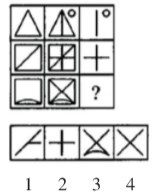
(A) 1
(B) 2
(C) 3
(D) 4
97. 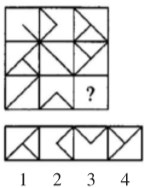
(A) 1
(B) 2
(C) 3
(D) 4
98. 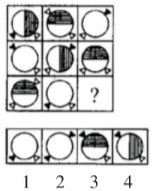
(A) 1
(B) 2
(C) 3
(D) 4
99. 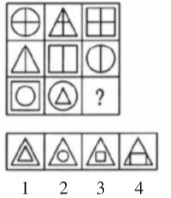
(A) 1
(B) 2
(C) 3
(D) 4
100. 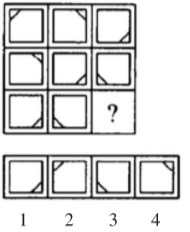
(A) 1
(B) 2
(C) 3
(D) 4

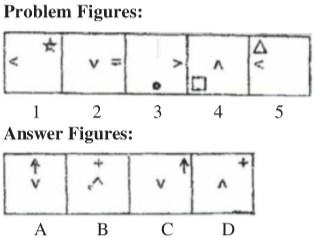
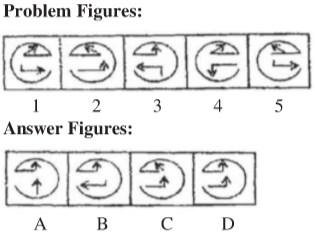
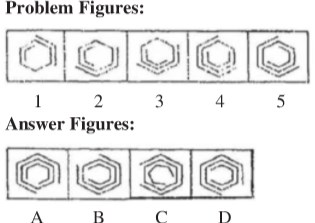
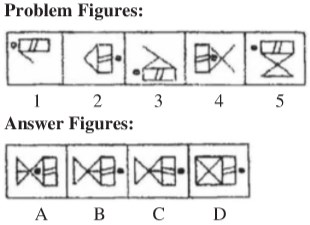
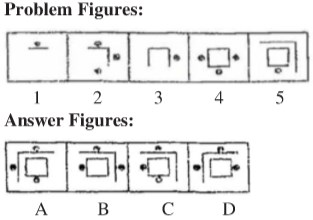
















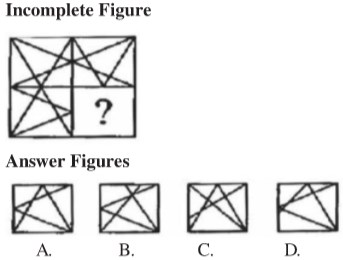
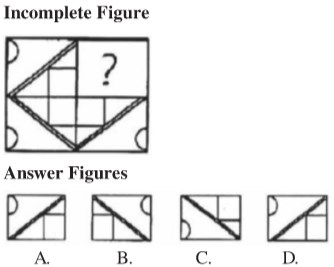
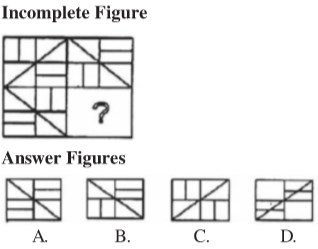
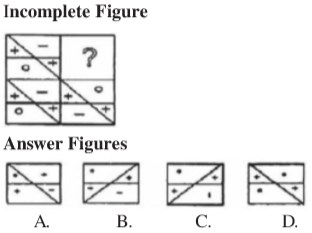












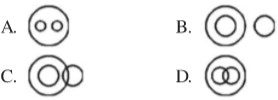
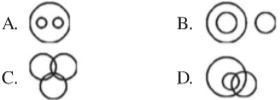
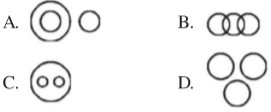

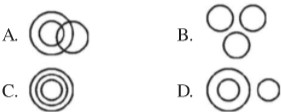
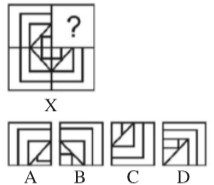
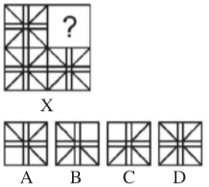
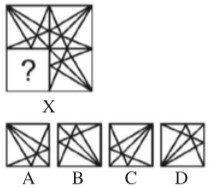


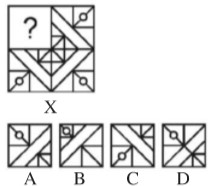
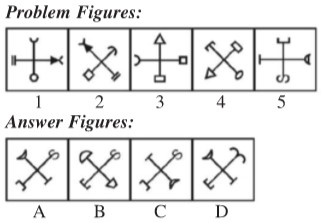
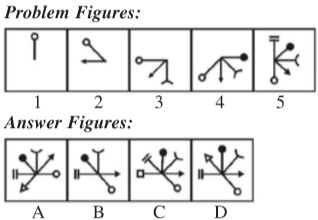
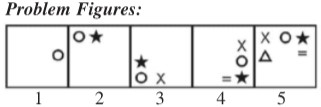
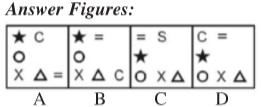
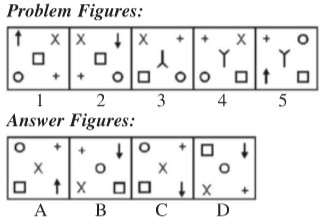
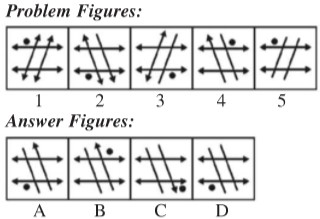





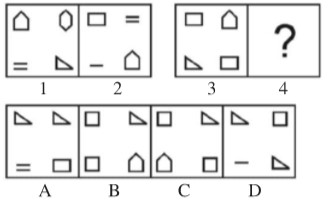
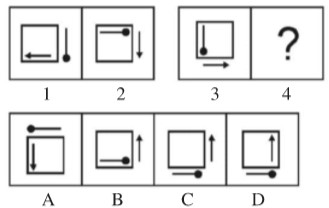
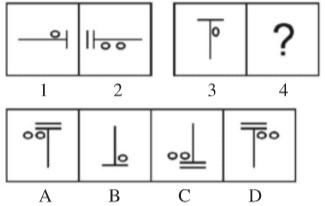
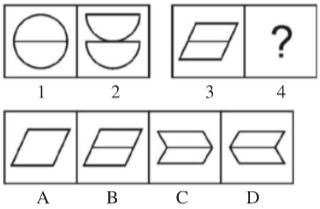
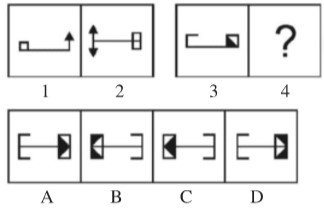

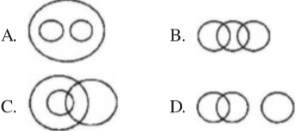
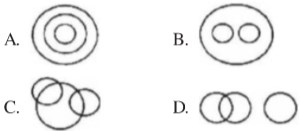
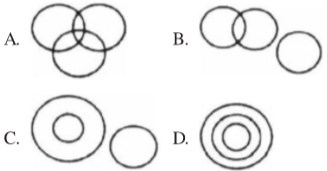
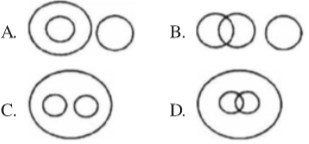
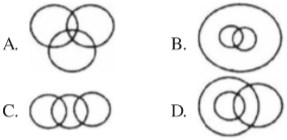












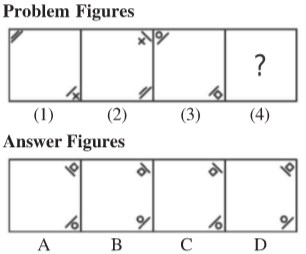
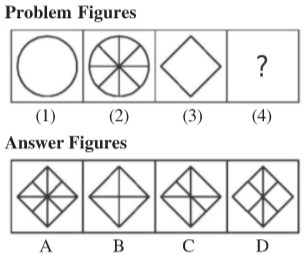

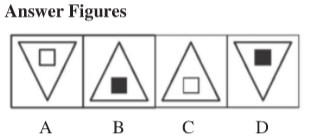
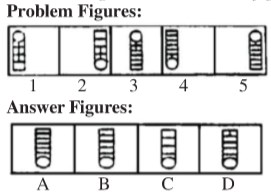
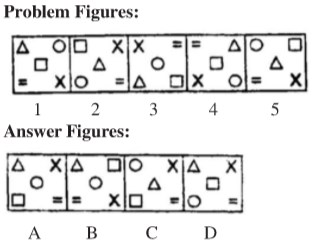






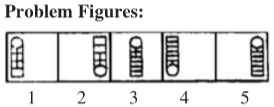

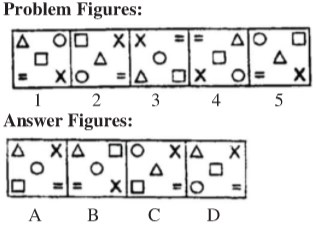

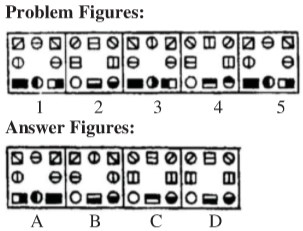
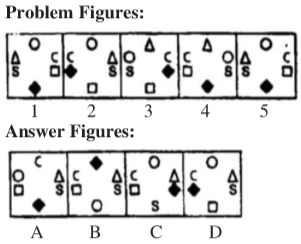




















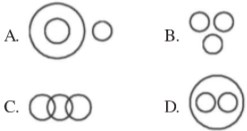
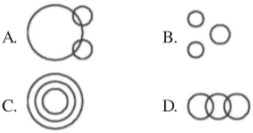
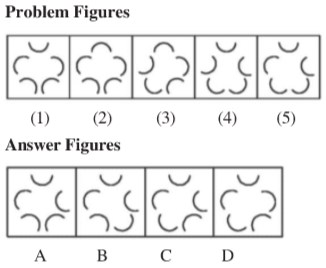
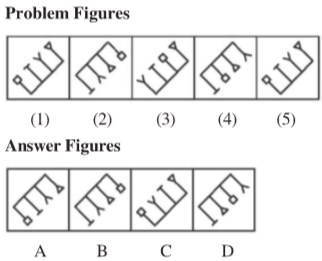
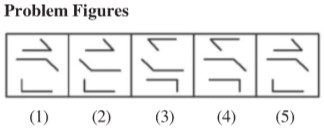

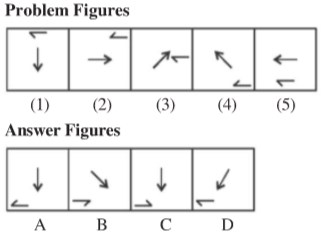
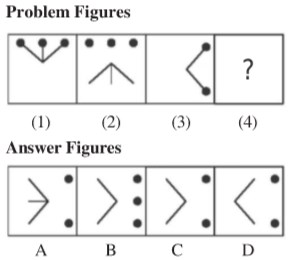
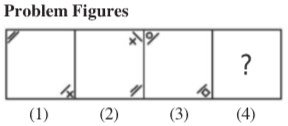
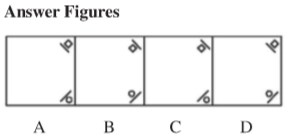
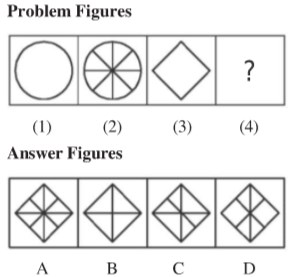
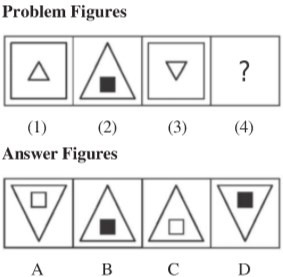
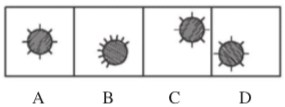
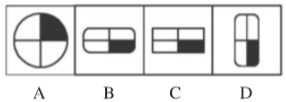
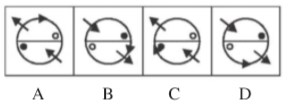



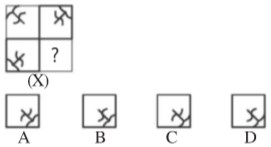











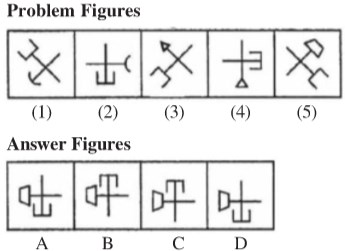
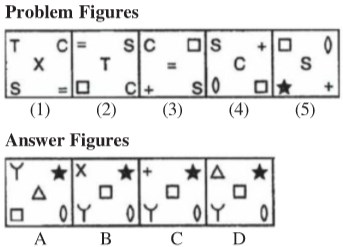
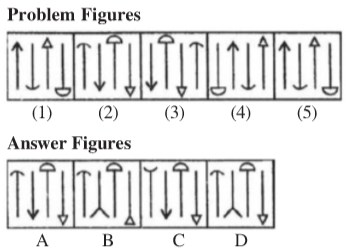
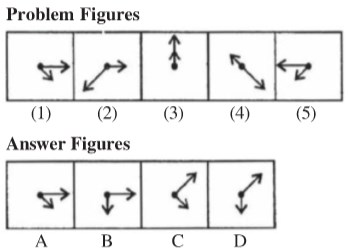
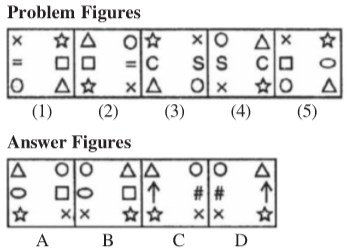
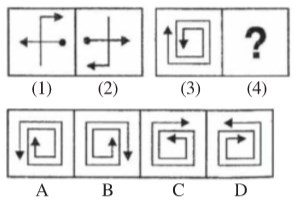
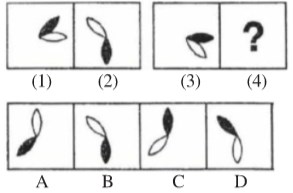











































 is equal to:
is equal to:











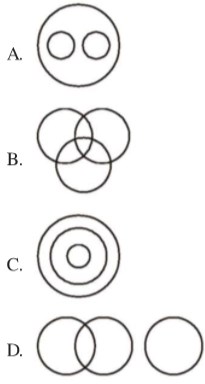


















 and x + y = 32, then find the value of z.
and x + y = 32, then find the value of z.